Genetic variation and superior provenances selection for wood properties of Larix olgensis at four trials
Heng Zhang · Shikai Zhang · Shuopeng Chen ·Dean Xia · Chuanping Yang · Xiyang Zhao
Abstract Larix olgensis, one of the most important timber species in northeastern China, is used for paper making and construction. In this study, 10 wood properties (wood density, f iber length, f iber width, f iber length- to width ratio,hemicellulose content, cellulose content, holocellulose content, lignin content, ash content, and carbon content) of 10 provenances of L. olgensis planted at sites of CuoHai (CH),JiaGeDaQi (JGDQ), LiangShui (LS), and Mao’erShan(MES) were analyzed. The results of ANOVA showed that almost traits diff ered signif icantly among locations and provenances, with a signif icant interaction eff ect. Each trait also diff ered signif icant among provenances within sites. The phenotypic and genetic coeffi cient of variation (PCV and GCV) and provenance heritability ( H 2 ) for wood properties ranged from 1.122 to 27.365%, from 0.564% to 21.113%and from 0.332 to 0.996, respectively. A correlation analysis showed that wood density was signif icantly negatively correlated with cellulose content and holocellulose content at sites CH, JGDQ, and LS, but were signif icantly positively correlated at site MES. Wood density was signif icantly negatively correlated with lignin content at CH and JGDQ,but not at LS and MES. Fiber width (FW) was negatively correlated with the ratio of f iber length (FL) to width across sites, and FW and FL/W were all positively correlated with FL. Lignin content was signif icantly positively correlated with hemicellulose content at site JGDQ and signif icantly negatively correlated with cellulose content and with holocellulose content at site MES. Interestingly, carbon content was positively correlated with cellulose content and holocellulose content at CH, but negatively correlated with these two traits at site MES. In a correlation analysis of wood properties with geographic, soil and climatic characteristics at the four sites, wood properties were mainly correlated with latitude and altitude of the site and aff ected by the average annual precipitation and temperature simultaneously.To select superior pulpwood provenances and high carbon storage provenances, we selected the two best provenances with excellent wood properties for each location based on a multi-trait comprehensive evaluation, which can be used as the preferred materials for the establishment of large-scale plantations in specif ic locations.
Keywords Larix olgensis · Wood properties · Genetic variation · Provenance selection · Carbon content
Introduction
Forests are the largest carbon sinks in terrestrial ecosystems and are important for sequestering CO2and mitigating the adverse eff ects of climate change (Peng et al. 2018). Therefore, the use of forest plantations for carbon sequestration is gaining more interest (Zhu et al. 2013). Large-scale reforestation and aff orestation have signif icant implications for carbon sequestration (Thomas et al. 2007), so screening and selecting provenances, families or clones for high carbon sequestration is a critical measure to optimize plantations as carbon sinks (Wang et al. 2016). Because the carbon sequestration capacity of conifers is signif icantly higher than that of broad-leaved tree species, conifers should be prioritized in programs for carbon sequestration forests (Xu et al. 2013).
Wood properties are important indices to evaluate wood yield and quality and are aff ected by environmental factors such as temperature, precipitation, soil conditions, competition, planting density, thinning density, slope position and direction, and interactions among these factors (Guo et al. 2002a, b; Shi et al. 2011). Poor site conditions can also reduce the number and length of f ibers (Wang et al. 2006).Genetic improvement of wood properties and selection of superior materials have always been an important directive for breeders and are needed to optimize timber production and carbon sequestration for aff orestation projects. Longterm provenance tests are essential to determine genetic and geographic variations in tree growth and recommend appropriate seed sources for reforestation, especially in a changing climate (Weber et al. 2019 ). Variations in growth traits (tree height and DBH) and wood properties (wood density and carbon concentration) also need to be studied to predict the ability of trees to sequester carbon in diff erent environments(Weber et al. 2018).
Larix olgensis, an important timber species, is mainly distributed in southeastern Heilongjiang, Liaoning, and Changbai Mountain area of Jilin, and it is also found in Korea and Russia (Hu et al. 2015). With excellent wood properties,it is not only used as wood f iber industrial raw materials,paper making raw materials and bio-fuels, but also used in industries such as construction, shipbuilding and railway(Xia et al. 2016). Because it is one of the main aff orestation species in northeastern China, its genetic improvement has been a research priority. Provenance tests ofL.olgensisin China were f irst started in the 1970s (Yang 1984). Superior pulpwood provenances and building timber provenances ofL. olgensishave been identif ied (Yu et al. 2015a, b), and genetic variations in carbon concentration and allocation among diff erent tissues at diff erent sites have been reported(Jiang et al. 2019). Large interactions between genotype and environment are known aff ect growth of this species (Sun et al. 2018; Wang et al. 2021; Zhang et al. 2021). However,Yin et al. ( 2017) found that correlation coeffi cients among growth traits and wood properties were mostly not signif icant. Therefore, it is necessary to study genetic variations in wood properties in diff erent environments.
In the present study, wood properties for 10 provenances ofL. olgensisfrom four sites were measured and their variations analyzed. The objectives of this study were to (1)determine the variation and heritability of wood properties for the provenances at diff erent sites; (2) estimate the phenotypic correlations among diff erent traits and the relationships between traits and geographic factors at the sites; and, (3)evaluate and select superior pulpwood provenances and high carbon storage provenances within the sites.
Materials and methods
Study area
Germplasm was collected from 10 provenances ofL. olgensisin its natural distribution area in 1980 to produce seedlings for provenance trials. Seedlings were planted in 1982 at four trial sites using a randomized complete block design.The locations and climatic characteristics of the trial sites and seedling spacing are given in Table 1.
Wood property measurements
One tree-ring core was collected three trees from each of three blocks for each provenance from each of the four sites from May to July in 2019. In total, 360 cores at breast height were obtained from south to north, and diameter at breast height(DBH) was measured. The cores were wrapped and put in paper tubes and taken to the laboratory for further analysis. All cores were placed in an oven at 80 °C for 48 h, then weighed every 2 h until the diff erence between the last two measurements was less than 0.5% of the total mass. Wood density was measured using the drainage method reported by Cheng( 1985). Fiber length (FL) and f iber width (FW) were measuredas detailed by Mu et al. ( 2009); the cores were divided into sapwood, heartwood, and pith, then each portion treating with nitric acid and chromic acid, and the length and width of 10 f ibers in each portion were measured, then the mean FL and FW of the 30 values were calculated for each core (tree).Hemicellulose content (HEC), lignin content (LC), cellulose content (CEC), holocellulose content (HOC) and ash content(AC) of each clone were measured using a fully automatic f iber analyzer according to the national standard GB/T 2677.1 93 (A2000i; ANKOM Technology, Macedon, NY, USA) and resistance furnace and the method of Xu et al. ( 2016). The carbon content (CAC) of each sample was measured with a Hydrocarbon analyzer Multi EA 4000 (Analytik Jena AG,Germany).

Table 1 Geographic and climatic characteristics and spacing of Larix olgensis at four sites in China
Statistical analyses
Statistical analyses were carried out using SPSS 25.0 software(IBM, Armonk, NY, USA). The following linear model was used for joint analysis of the four sites together andFtests was performed to estimate the signif icance of ANOVA (Zhao et al. 2014):
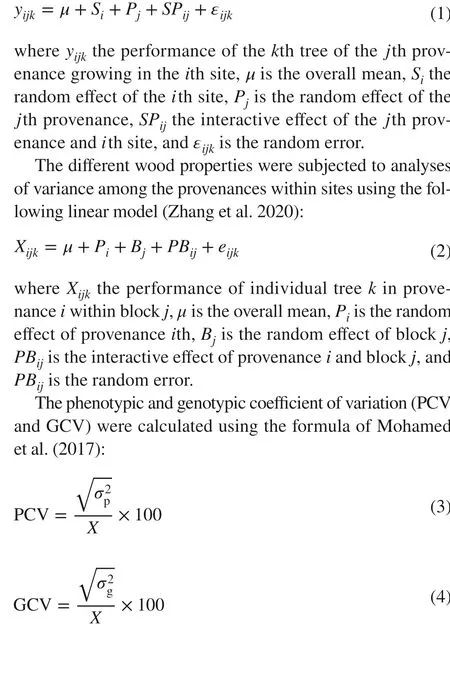
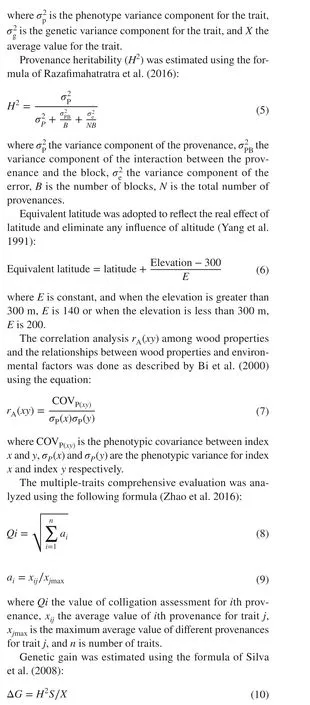
whereH2,S, andXare provenance heritability, selection diff erence, and mean value of the given trait, respectively.
Results
Estimates of variance components
The analysis of variance showed that diff erent wood properties reached signif icant diff erence level (P< 0.01) among sites and the interactions between sites and provenances during the multi-site joint analysis, while only WD, FL, and FL/W diff ered signif icantly among the diff erent provenances(Table 2), indicating environmental eff ects were a predominant source of variation. Variance components among sites were all higher than those among provenances and their interactions. Therefore, it was necessary to screen for superior provenances within each site. Signif icant diff erences for diff erent properties were detected among provenances within sites (P< 0.01), except for FW and FL/W, while the diff erences among the blocks and the interactions between provenances and blocks were mostly insignif icant (Table 3),indicating high variation among provenances.
Trait means
The means for diff erent properties of all provenances within sites are shown in Table 4. The mean DBH ranged from 17.59 to 28.51 cm across sites, and was largest at site MES and lowest at CH. The mean WD at site LS (0.576 g cm -3 )was signif icantly lower than those at the other three sites,especially compared with MES (0.645 g cm -3 ). The mean FL, FW, and FL/W ranged from 2088.19 (MES) to 2404.27 μm (JGDQ), from 33.14 (LS) to 36.91 μm (JGDQ),and from 57.57 (MES) to 72.82 (LS), respectively. FL/W for all provenances at LS was higher than that at MES. The mean HEC, CEC, HOC, LC, and AC ranged from 9.27(MES) to 10.601% (JGDQ), from 38.18 (MES) to 44.19%(LS), from 47.45% (MES) to 53.60% (LS), from 27.74(JGDQ) to 30.55% (MES), and from 0.47 (JGDQ) to 0.58%(LS), respectively. HEC at CH and JGDQ was higher than at LS and MES, CEC and HOC at site MES were lower than at the other three sites, and LC at site MES was the highest. The mean CAC for sites JGDQ, LS, and MES was 456.96 g kg -1 , 457.42 g kg -1 , and 454.21 g kg -1 respectively,and the lowest mean was at site CH (442.48 g kg -1 ). Across sites, WD was higher for provenances DHL and DST than for the other provenances across sites and lowest for provenance HL. Provenance LSH had the lowest values for WD at sites CH and LS, however, it was higher at sites of JGDQ and MES. FL/W for provenance DHL was lower than others at 4 sites, and higher for DST. HOC for provenance DHL was lower at sites CH, JGDQ, and LS than at site MES, but the opposite for provenance DHL. CAC diff ered signif icantly across all sites for each provenance (e.g., provenance LSH had higher CAC at CH, LS and MES than at JGDQ). Values for CAC of provenance XBH were lower across all sites, and those for provenance HL were higher across sites, except at LS. Provenance BH were the highest at site JGDQ and lowest at site LS, whereas those for provenance ML were the highest at LS and lowest at MES.
Genetic variability for wood traits
The genetic variability parameters calculated for the wood properties of the 10 provenances at each site are shown in Table 5. The PCV and GCV for AC were highest and allmoderate, whereas those for CAC were the lowest. At site CH, the maximum for PCV was 19.546% and 14.430%for GCV. The maximum PCV and GCV at site JGDQ was 27.365% and 21.113%, respectively. The maximum PCV and GCV at site LS was 18.376% and 14.855%, respectively. The maximum PCV and GCV at site MES were 18.871% and 13.811%, respectively. In addition, the PCVs and GCVs for the other properties were almost always low. TheH2 for the diff erent traits at CH ranged from 0.599 (FL/W) to 0.971(CEC and HOC). The lowestH2 at site JGDQ was 0.467(LC), and the highest was 0.976 (HOC). TheH2 for the different traits at LS ranged from 0.663 (FL/W) to 0.996 (AC).The lowestH2 at site JGDQ was 0.332 (FL/W), and the highest was 0.986 (AC). Nearly all traits had high heritability.

Table 2 Results of ANOVA for diff erent wood properties of Larix olgensis at four sites in China
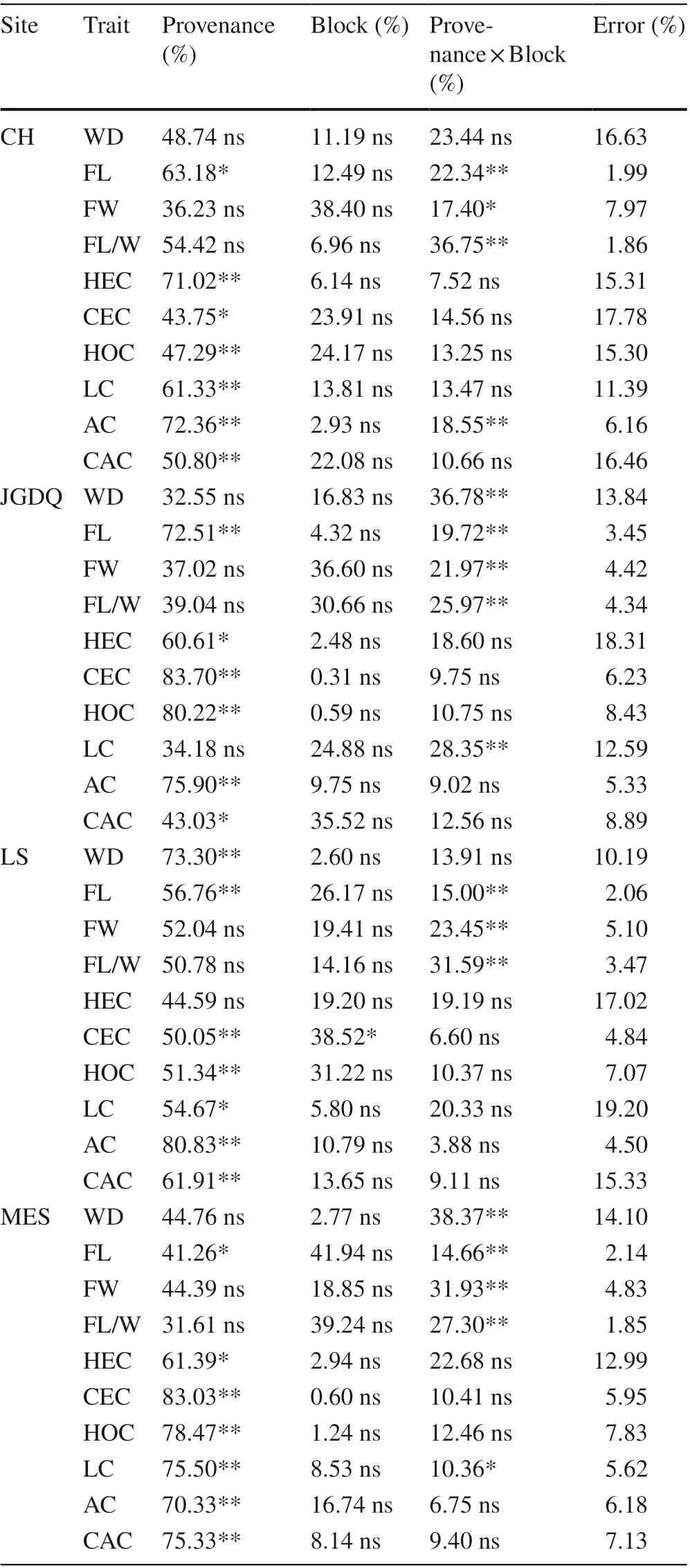
Table 3 Variance components of diff erent traits for the 10 provenances of Larix olgensis at four sites in China
Inter-trait correlation analysis
The correlation coeffi cients between diff erent properties within sites are shown in Table 6. There were signif icant correlations between traits DBH and WD at sites CH and LS, but not at other sites. DBH was signif icantly correlated with FL and FW at sites JGDQ and LS and negatively correlated with LC at sites CH and MES. WD was negatively correlated with CEC and HOC across all sites but MES. FW was negatively correlated with FL/W across all sites, and FW and FL/W all positively correlated with FL. HOC was positively correlated with HEC and with CEC across sites.It was interesting that CAC was positively correlated with CEC and HOC at CH, but negatively correlated with these two traits at site MES. In addition, CAC was signif icantly positively correlated with LC only at site MES. LC was positively correlated with HEC at site JGDQ and negatively correlated with CEC and HOC at site MES.
Geographic variations
The correlation coeffi cients between wood properties and geographic and climatic factors at the four sites are given in Table 7. WD was negatively correlated with elevation and positively correlated with temperature. FL was positively correlated with latitude (equivalent latitude) and elevation and negatively correlated with precipitation and temperature,while FL/W was only positively correlated with elevation.HEC, CEC and HOC were positively correlated with latitude(equivalent latitude) and elevation and negatively correlated with precipitation, but there was a signif icant negative correlation between HEC and longitude and between CEC and HOC with temperature. LC was negatively correlated with latitude (equivalent latitude) and elevation and positively correlated with precipitation and temperature. CAC was positively correlated with longitude, elevation, and precipitation but negatively correlated with temperature.
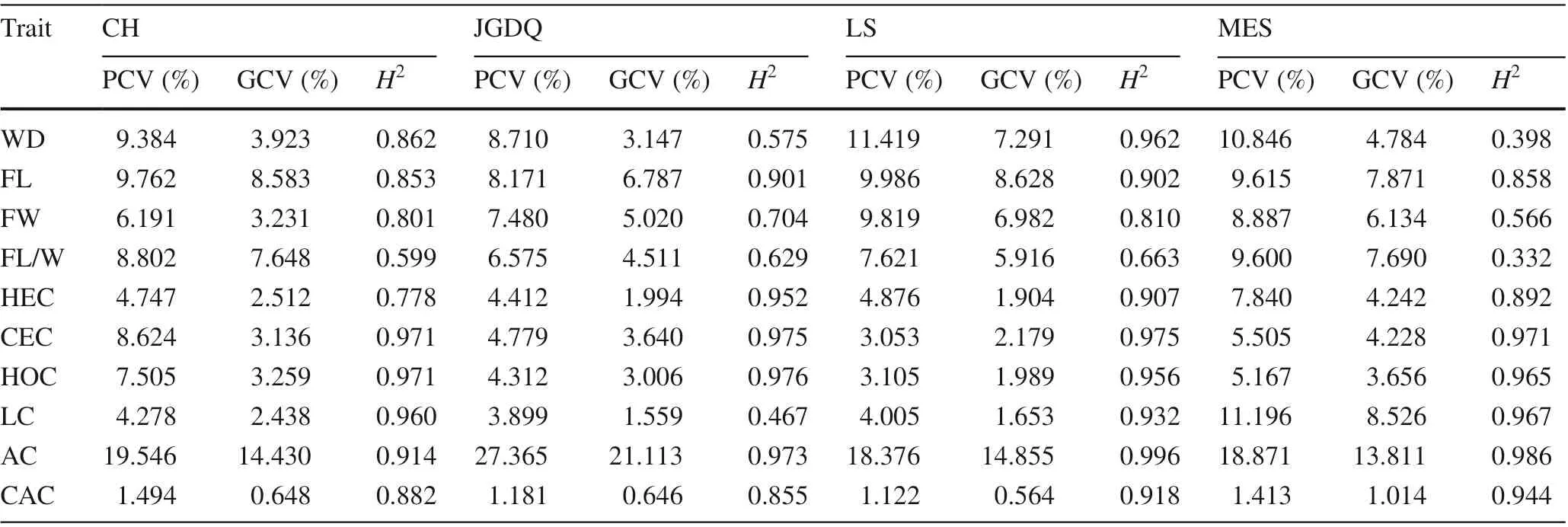
Table 5 Genetic variability parameters for diff erent wood traits of Larix olgensis at four sites in China
Comprehensive evaluation and genetic gain
For the selection of superior pulpwood provenances and high carbon storage provenances, the results of the comprehensive evaluation of diff erent wood properties and Qi values for the provenances across sites are shown in Table 8. From the perspective of pulpwood provenances, WD, FL, HEC,CEC, HOC, LC, and AC were regarded as indicators, and the values for LC and AC were calculated using negative numbers because of the negative eff ects of papermaking.As for high carbon storage provenances, WD, HEC, CEC,HOC, LC, AC, and CAC were used as evaluation indices,and AC was used as negative number in the calculation.Properties that had no signif icant eff ect among provenances within sites were eliminated. At site CH, the Qi value for pulpwood ranged from 1.261 (DHL) to 1.547 (BH) and for high carbon storage from 1.936 (DHL) to 2.080 (BH). At site JGDQ, Qi for pulpwood ranged from 1.642 (DHL) to 1.785 (LSH) and for high carbon storage from 1.704 (DHL)to 1.822 (LSH). At site LS, Qi for pulpwood ranged from 1.251 (BH) to 1.490 (DST) and for high carbon storage from 1.934 (BH) to 2.038 (DST). At site MES, Qi for pulpwood ranged from 1.257 (TQL) to 1.546 (DST) and for high carbon storage from 1.941 (TQL) to 2.013 (LSH). Pulpwood and high carbon storage were regarded as selected targets,with a selection rate of 20%, two superior provenances were selected at each site. The genetic gains for diff erent traits of the superior provenances are shown in Table 9. From the view of pulpwood, the superior provenances selected at CH, JGDQ, LS, and MES were BH and BDS, LSH and JX, DST and JX, and DST and XBH, respectively. On the other hand, the superior high carbon storage provenances at 4 sites were BH and HL, LSH and JX, DST and HL, and DST and LSH, respectively. The genetic gains of diff erent traits for superior provenances were shown in Table 9. As was shown, the genetic gain for WD at LS was ranged from 7.44 to 10.19%. Meanwhile, the genetic gains for FL at different sites were ranged from 0.19 to 11.14%. The genetic gains at the diff erent sites ranged from -4.59 to 2.13% for HEC, from 0.40 to 4.16% for CEC, from 0.51 to 3.08% for HOC, from -11.40 to 0.44% for LC, and from -17.96 to-6.07% for AC. For CAC, the genetic gain was 0.57% at CH, -0.13% at JGDQ, -0.12% at LS, and 0.30% at MES.
Discussion
Tree growth and wood quality were aff ected by a variety of factors such as genotype, temperature, precipitation, soil conditions, and their interactions (Fang et al. 2020). Heritability was closely related to climatic factors. Therefore,heritability of diff erent traits for the same provenance or family will certainly diff er among the sites. Our analysis of variance for wood properties ofL. olgensisprovenances at the four sites showed that all traits diff ered signif icantly among diff erent sites, indicating that the diff erent conditions had vital eff ects on plant growth. The values for the wood traits also diff ered among the diff erent provenances within each site, indicating that the evaluation and selection of provenances within sites were eff ective. The phenotypic and genotypic coeffi cients of variation for almost all properties at the diff erent sites were lower than those reported for 26-year-old clones ofL. olgensis(Yin et al. 2017); however,the provenance heritability in the present study was higher than that found by Yin et al. ( 2017).
Wood density is a strong determinant of mechanical strength, which affects wood quality and potential uses(Lundqvist et al. 2018) and is considered the main physicalvariable and key index for evaluating wood quality and pulp yield (Ortega Rodriguez and Tomazello-Filho 2019). An increase in wood density has an important eff ect on the effi -ciency of pulp production (Niemczyk and Thomas 2020).Site is also an important factor with a strong eff ect on wood density (Dias et al. 2018). In the present study, the average wood density ofL. olgensisprovenances at all sites was 0.612 g cm -3 , with the maximum of 0.645 g cm -3 found at MES and the minimum of 0.576 g cm -3 at LS, both signif icantly higher than obtained by Li and Lian ( 2017a). This difference might be due to diff ering aff orestation densities. In addition, the wood density of the DHL and DST provenanceswas greater than 0.600 g cm -3 at all the sites, and less than 0.600 g cm -3 for provenance HL at all the sites, indicating that although the same provenances had certain diff erences in the diff erent site conditions, the provenances had certain commonalities in their site responses.
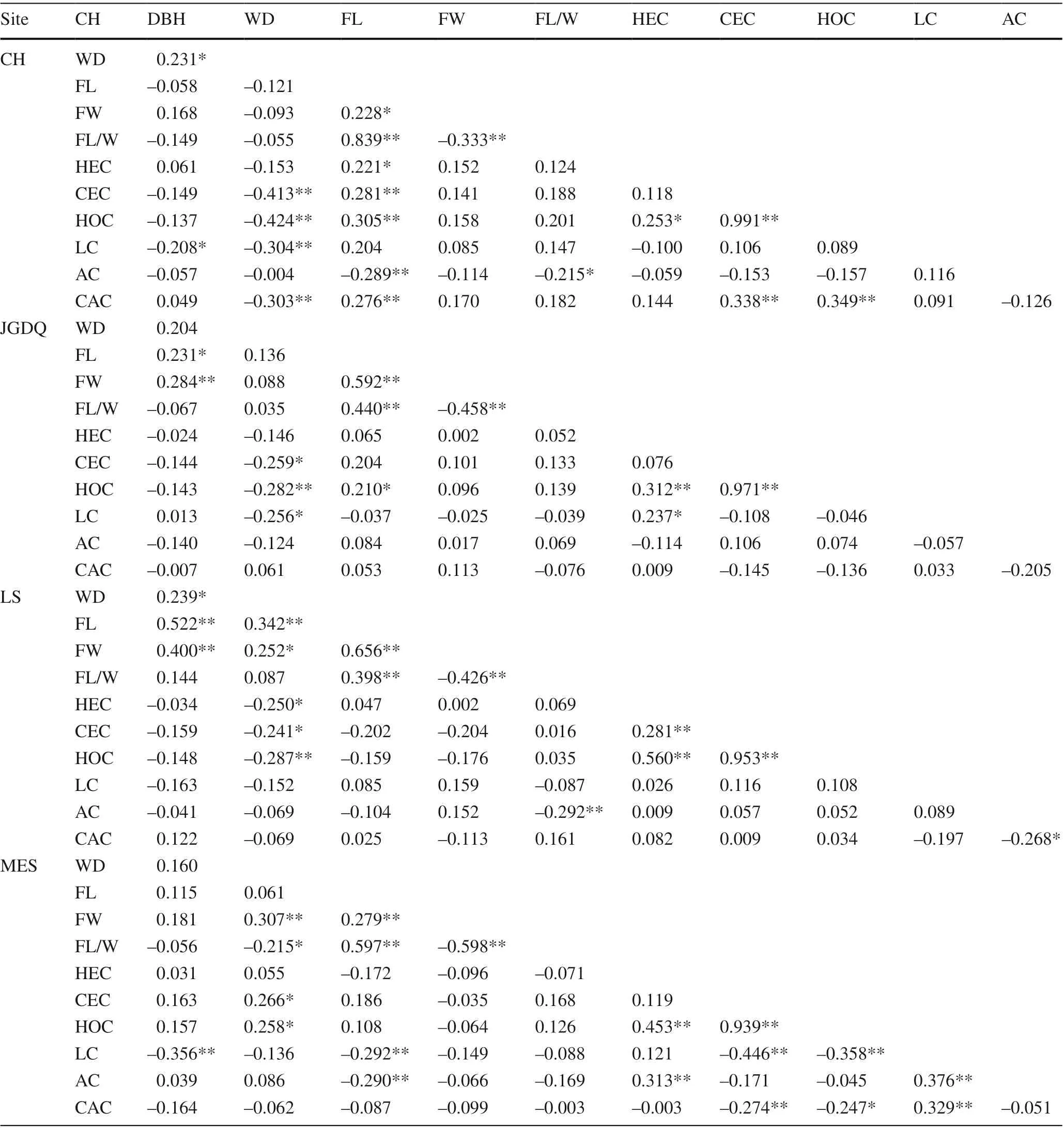
Table 6 Correlation coeffi cients for wood properties of Larix olgensis at four sites in China

Table 7 Correlation coeffi cients of wood traits of Larix olgensis and geographic and climatic factors at four sites in China
Pulp properties and paper quality are mainly inf luenced by wood f iber traits (f iber length and f iber length to width ratio) (Liu et al. 2020). The greater the f iber length to width ratio, the more times the f ibers can be mixed and the better the combinability of the f ibers, which gives the paper greater strength (Bai et al. 2009). In this study, the average f iber length was 2266.602 μm, considered as a long f iber. The average f iber length and f iber width were similar to previous f indings (Shi et al. 2011). The average f iber length to width ratio was 65.68, higher than reported forPopulus deltoidsby Wu et al. ( 2011); therefore,L. olgensisis categorized as high-quality material for papermaking.
In the process of genetic improvement of forest trees,multiple traits are increasingly expected to be improved simultaneously (Lin 2010); thus, correlation analyses can provide a reference guide for joint breeding of multiple traits(Jia et al. 2016). However, genetic correlations between growth and wood traits are likely to depend on the trial site(Li et al. 2017). In the present study, DBH and WD were signif icantly correlated, which disagrees with a report forPinus taeda(Xu et al. 2000). However, the WD ofLarix kaempferiis negatively related to growth rate of juveniles and was not correlated with growth rate at maturity (Zhu et al. 2000). Similarly, Stackpole et al. ( 2010) found a signif icant negative genetic correlation forEucalyptus globulusbetween basic wood density and diameter at the selection age (4-5 years); however, at the harvest age, the genetic correlation was not signif icant and slightly positive. Zhang et al. ( 2014) found a weak positive correlation between DBH and WD for triploid hybrid clones ofPopulus tomentosa.Here, we found that wood density was negatively correlated with cellulose content at all sites except MES, whereas Guo et al. ( 2014) found a signif icant positive correlation between these traits forSalix suchowensisand a negative correlation between WD and hemicellulose content; these diff erences might be related to the tree species. The correlation between f iber length and f iber width was extremely signif icant and positive, similar to the results of Liang et al. ( 2016) forPinus koraiensis. ForL. olgensis, f iber length was signif icantly correlated with hemicellulose content, which indicates that f iber qualities were closely related to chemical composition.Interestingly, CAC was positively correlated with CEC and HOC at CH, but they were negatively correlated at MES,which might be due to CAC was signif icantly positively correlated with LC at MES, and lignin contains more carbon than cellulose does (Weber et al. 2018).
The results of the correlation analysis between wood traits and geographic factors of the trial sites showed a signif icant negative correlation between wood density and altitude,agreeing with f inding that the wood density ofPinus nigradecreased with an increase in altitude (Dias et al. 2018).Similarly, growingAlnus formosanaat lower latitudes increased the wood density (Yang et al. 2012). Although wood density is a heritable trait, it interacts with the meteorological variables (Rocha et al. 2020). Here we found a signif icant positive correlation between wood density and temperature; the higher the temperature, the earlier cambial activity can begin, and as cell division accelerates, more wood cells are produced, which can increase wood density(Xu et al. 2011). The correlations between wood f iber length and latitude, equivalent latitude and altitude were extremely signif icant, contrary to the results of Yang et al. ( 2009). This f inding might be due to the fact that JGDQ is at a high latitude with appropriate temperature and precipitation forL.olgensis, positively inf luencing growth. At the same time,f iber length was signif icantly negatively correlated with the annual average precipitation and temperature, consistentwith the results of Zhang et al. ( 2011) for cotton; appropriate precipitation was conducive to an increase in cotton f iber length, whereas excessive precipitation resulted in shorter f ibers. Our correlation analysis showed that carbon content was signif icantly positively correlated with longitude, altitude and annual precipitation and signif icantly negatively correlated with annual average temperature, similar to the results of Zhou ( 2015) onFraxinus mandshurica; temperature decreases as altitude increases, plant growth rate slows,which increases the degree of lignif ication, and resulting in greater carbon content.
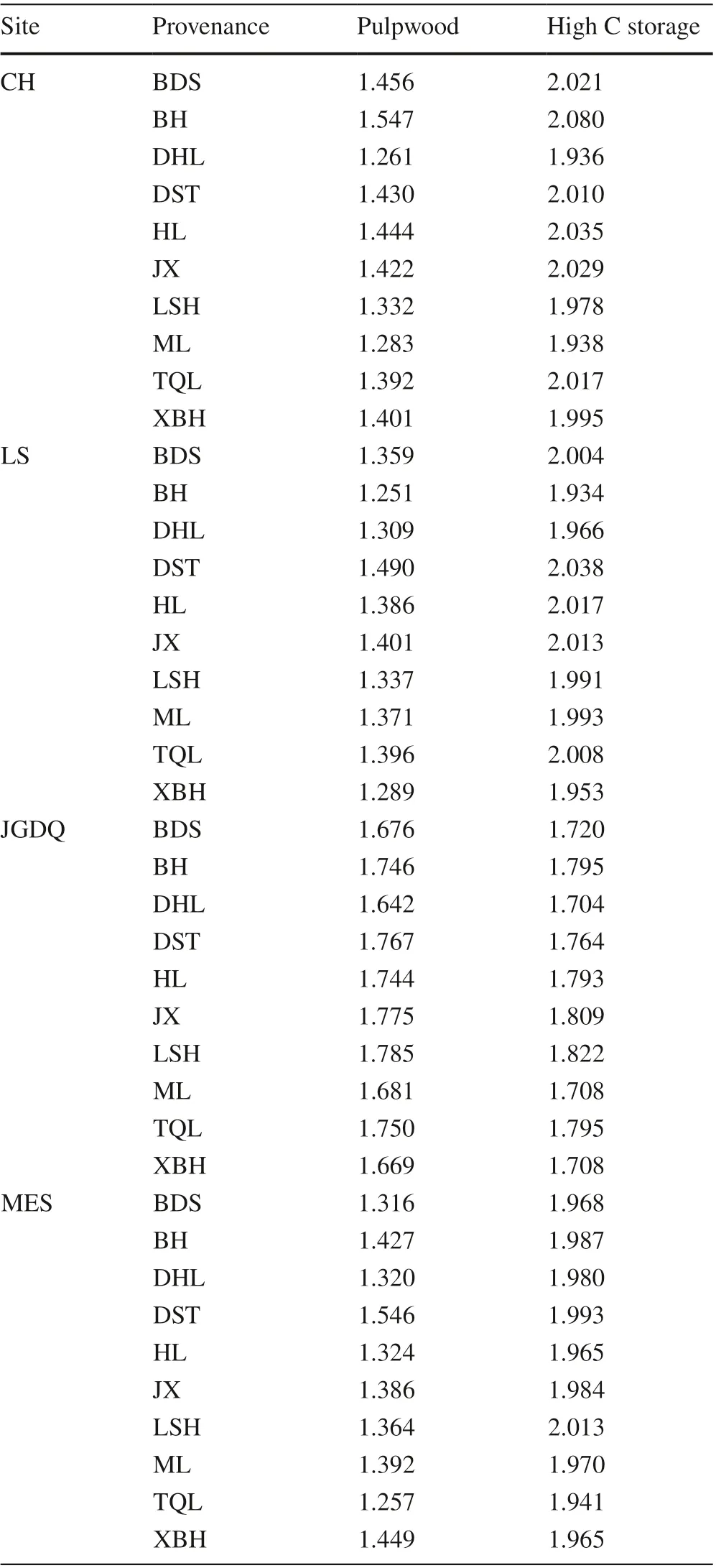
Table 8 Qi values of diff erent provenances of Larix olgensis at four sites in China
The best provenance must be selected for a given site or region to achieve maximum plantation productivity (Loha et al. 2009). In the past, growth traits, wood quality, and disease resistance have been the main criteria for selecting suitable reproductive material for tree species (Buras et al.2020). Our correlation analysis of numerous wood traits at four sites allowed us to select superior pulpwood provenances and high carbon storage provenances for the sites,although the genetic gains were lower than for the elites selected by Yin et al. ( 2017), probably due to the diff erent tree ages or the number of materials (provenances and clones).
Conclusions
Our results on genetic and geographic variations in the wood properties of 10L. olgensisprovenances at four sites showed a signif icant diff erence in wood properties among the sites,provenances, and their interactions. Wood traits were mainly related to the latitude and altitude of the site and were also aff ected by annual precipitation and temperature. Superior pulpwood provenances and high carbon storage provenances within sites could be selected separately for use as the preferred aff orestation material for a particular site.
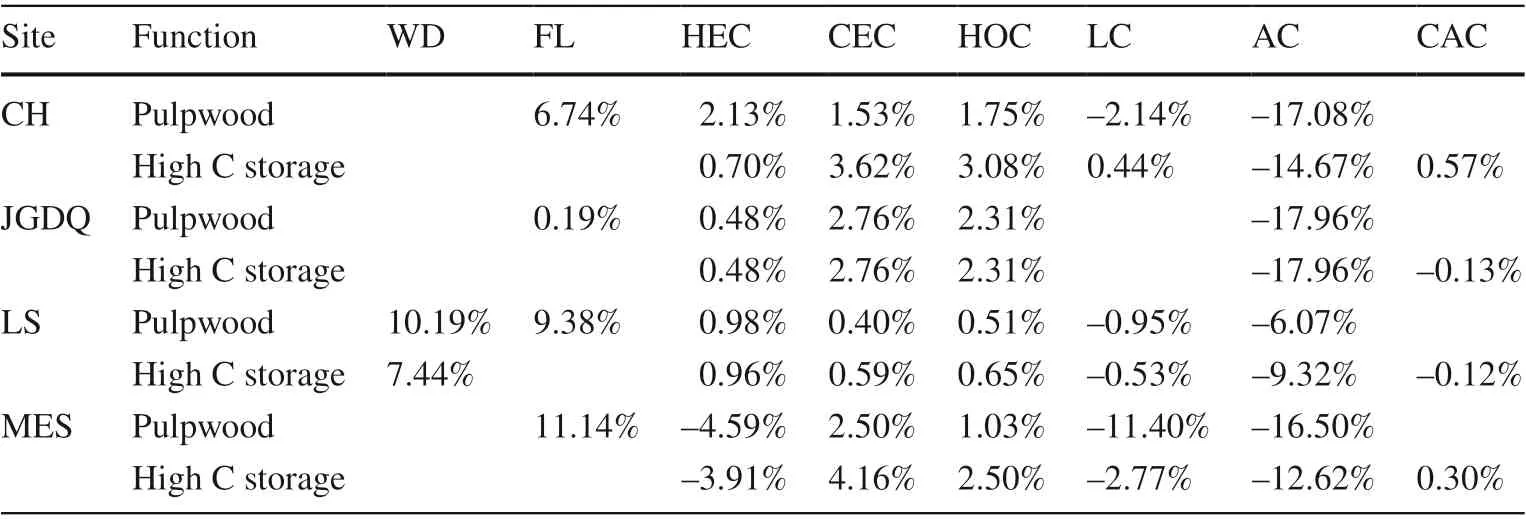
Table 9 Genetic gains of diff erent wood traits of Larix olgensis within four sites in China
Author’s contributions H Zhang, CP Yang, and XY Zhao planned and designed the research. H Zhang and SP Chen did the experiments and f ieldwork. H Zhang analyzed data and wrote the manuscript.SK Zhang and DA Xia provided helpful comments on the draft and reviewed and edited the manuscript.
Open Access This article is licensed under a Creative Commons Attribution 4.0 International License, which permits use, sharing, adaptation, distribution and reproduction in any medium or format, as long as you give appropriate credit to the original author(s) and the source,provide a link to the Creative Commons licence, and indicate if changes were made. The images or other third party material in this article are included in the article’s Creative Commons licence, unless indicated otherwise in a credit line to the material. If material is not included in the article’s Creative Commons licence and your intended use is not permitted by statutory regulation or exceeds the permitted use, you will need to obtain permission directly from the copyright holder. To view a copy of this licence, visit http:// creat iveco mmons. org/ licen ses/ by/4. 0/.
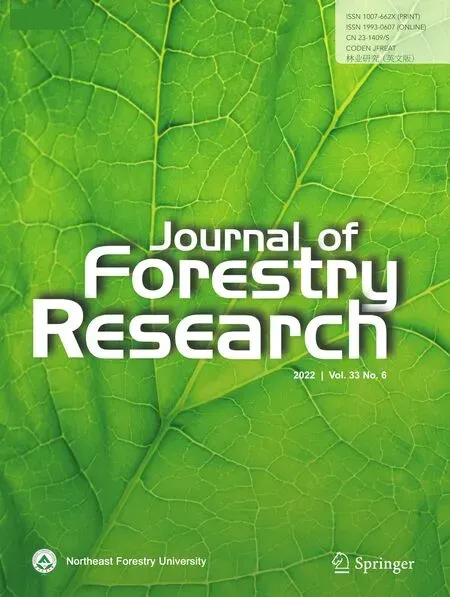 Journal of Forestry Research2022年6期
Journal of Forestry Research2022年6期
- Journal of Forestry Research的其它文章
- Mixing planting proportions in a plantation aff ects functional traits and biomass allocation of Cunninghamia lanceolata and Phoebe bournei seedlings
- Intraspecif ic leaf morphological variation in Quercus dentata Thunb.: a comparison of traditional and geometric morphometric methods, a pilot study
- Mapping the potential distribution suitability of 16 tree species under climate change in northeastern China using Maxent modelling
- Correction to: Eff ects of active molecules of Korean pine seed on rodent health and implications for forest regeneration
- Seed, germination, and seed-reserve traits diff er along an altitudinal gradient
- Analysis of the chloroplast genomes of four Pinus species in Northeast China: Insights into hybrid speciation and identif ication of DNA molecular markers
